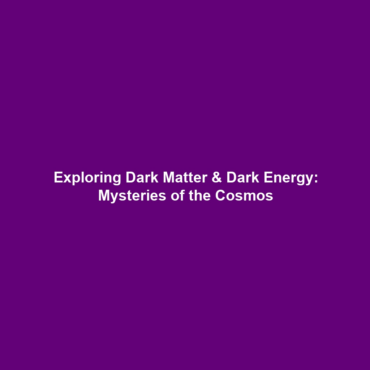Subtopics in Dark Matter and Dark Energy
Introduction
The exploration of subtopics within Dark Matter and Dark Energy is integral to our understanding of the universe. These enigmatic components of cosmology make up approximately 95% of the universe’s total mass-energy content, yet they remain largely unexplored and misunderstood. By delving into specific subtopics, scientists hope to unveil the complex interactions and implications these phenomena have for theoretical physics and observational astronomy.
Key Concepts
The study of subtopics involves several major concepts and principles that illuminate their relevance to the broader theories of Dark Matter and Dark Energy.
Subtopic 1: Particle Candidates
Current theories suggest various candidates for Dark Matter particles, including Weakly Interacting Massive Particles (WIMPs) and axions. Understanding these subtopics is crucial for developing detection methods and understanding their implications in cosmology.
Subtopic 2: The Cosmic Microwave Background
The Cosmic Microwave Background (CMB) provides critical insights into Dark Energy. Analysis of the CMB allows scientists to explore how dark energy influences the rate of cosmic expansion, revealing deeper understanding through the study of its anisotropies.
Subtopic 3: Gravitational Lensing
Gravitational Lensing is another subtopic of interest; it offers a unique method for observing the distribution of dark matter in the universe by studying how light from distant objects is bent around massive foreground objects.
Applications and Real-World Uses
Research into subtopics within Dark Matter and Dark Energy has numerous applications:
- Astrophysics Research: Advancements in understanding dark matter help refine astrophysical models.
- Space Exploration: Knowledge of dark energy assists in predicting the long-term evolution of the universe.
- Technological Innovations: Techniques developed for dark matter detection lead to innovations in sensor technology.
Current Challenges
Despite advancements, there are significant challenges associated with studying subtopics in the context of Dark Matter and Dark Energy, including:
- Difficulty in detecting dark matter particles directly due to their weak interactions with ordinary matter.
- Limited observational data regarding the effects of dark energy on cosmic expansion.
- Theoretical uncertainties in models of dark energy and its implications for accelerated expansion.
Future Research and Innovations
Future research promises exciting innovations in understanding subtopics related to Dark Matter and Dark Energy:
- Next-Generation Experiments: Upcoming particle detectors aim to identify candidates for dark matter.
- Advancements in Cosmology: Improved telescopes will enhance the study of the universe’s expansion and its correlation with dark energy.
- Computational Models: Enhanced simulations will refine our understanding of how these components interact at cosmic scales.
Conclusion
Understanding the various subtopics related to Dark Matter and Dark Energy is essential for unraveling the mysteries of the universe. Continued research in these areas promises to yield profound insights and breakthroughs. To learn more about related topics, visit our comprehensive sections on Dark Matter and Dark Energy.

Leave a Reply